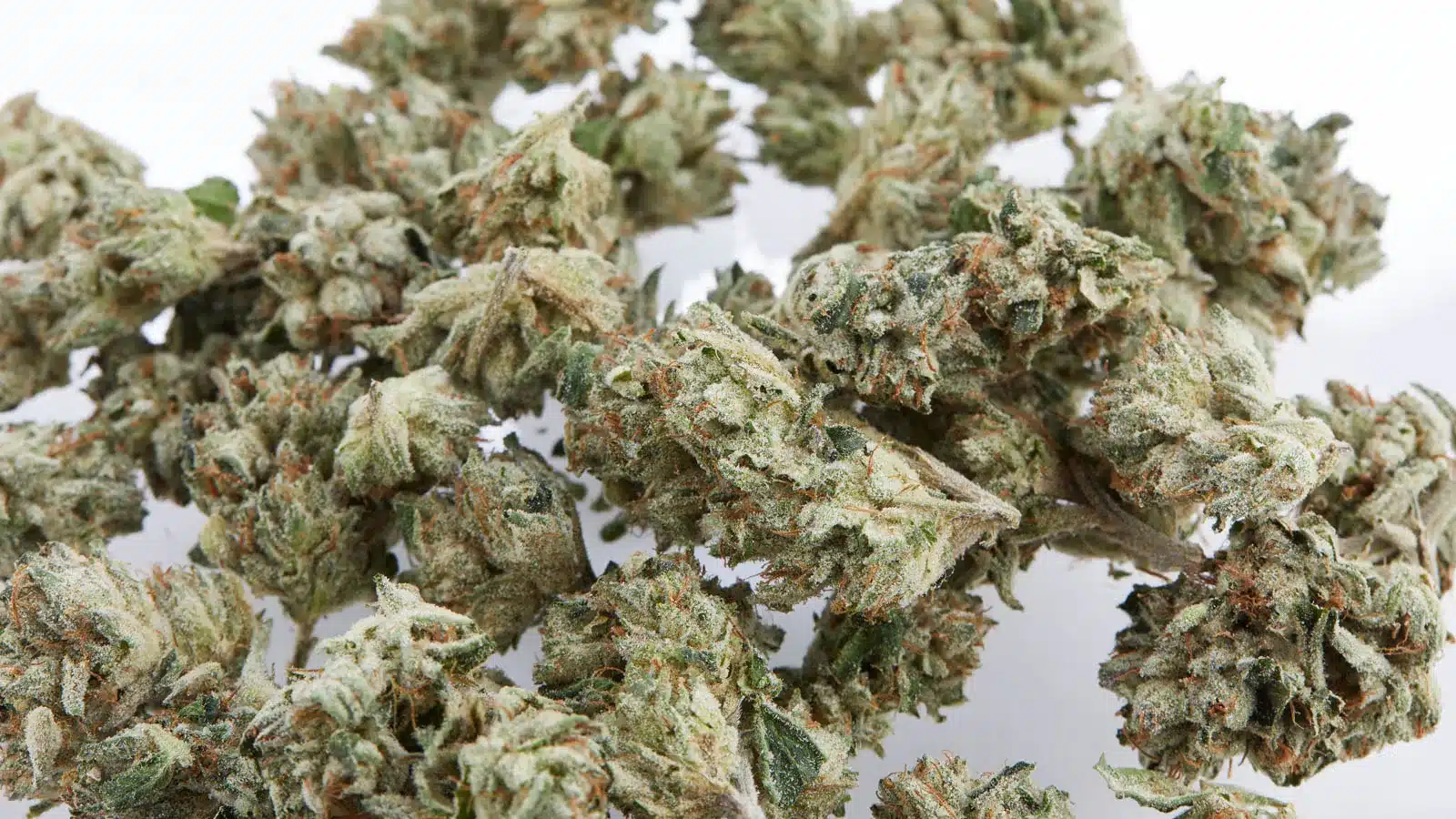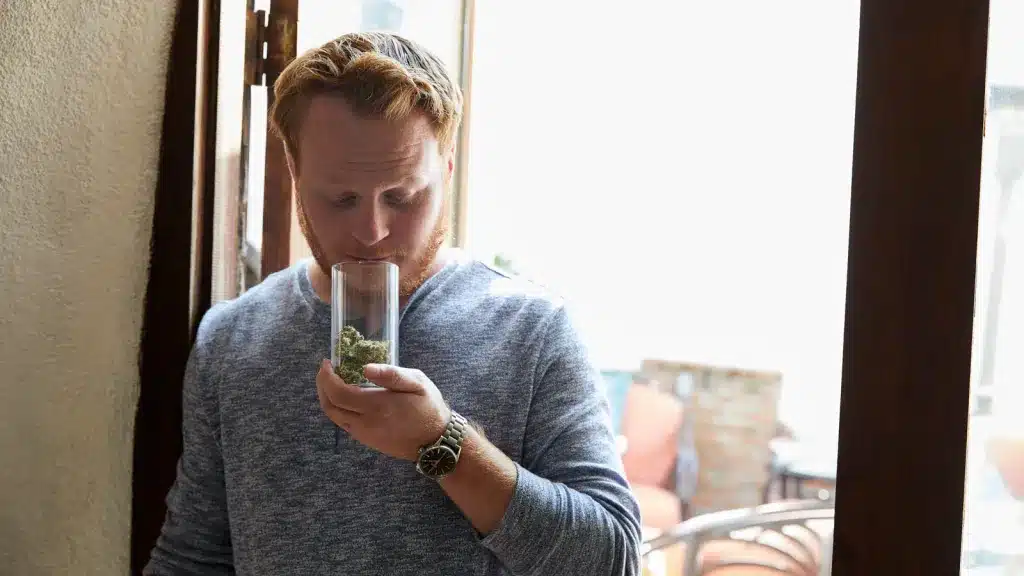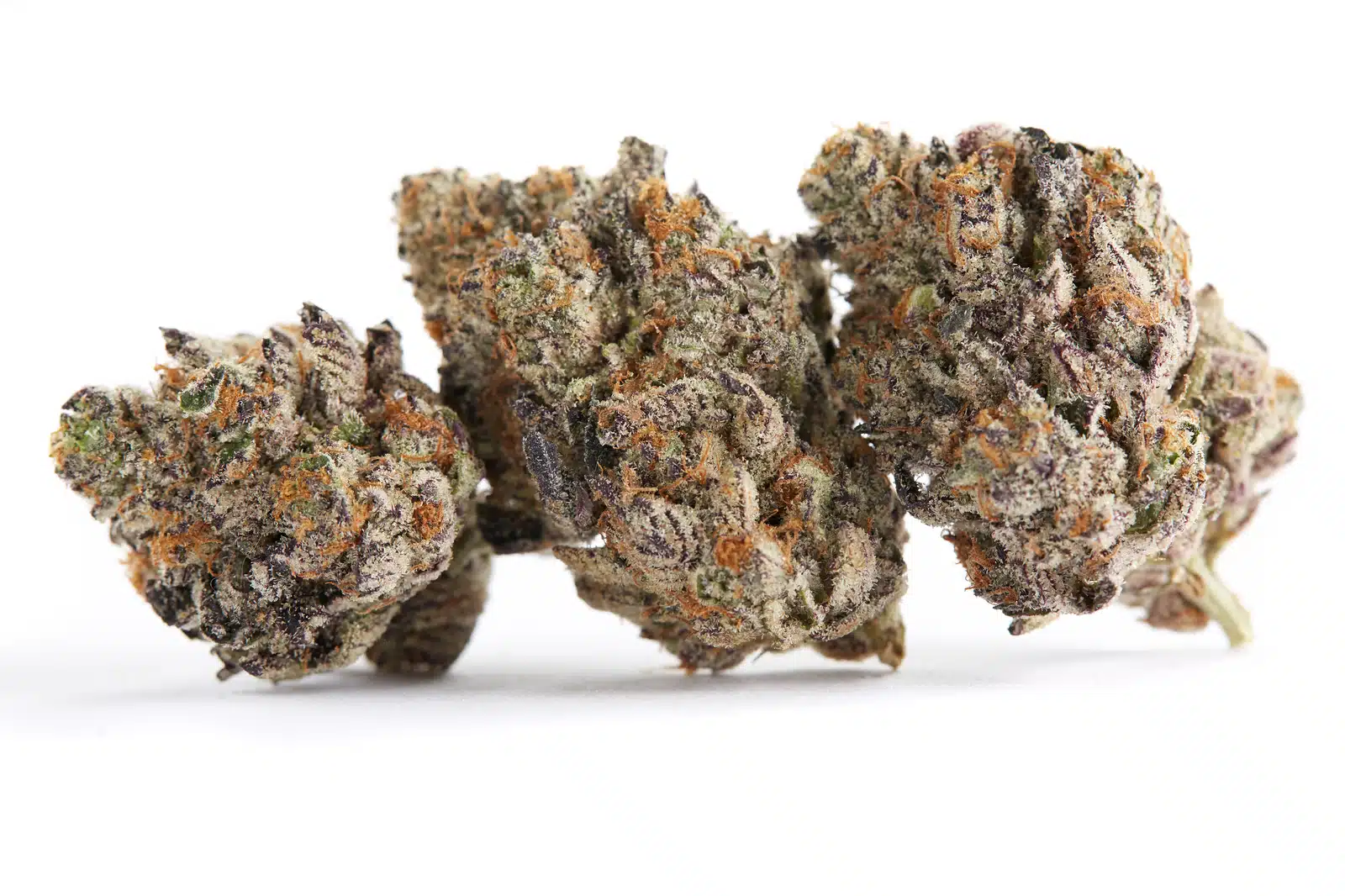Defining high-quality cannabis
To start off, let’s familiarize ourselves with the basic lingo used in the cannabis marketplace. “Flower” signifies the matured, dried, and cured blooms of the female cannabis plant, colloquially known as “nugs” or “buds.” These are generally rich in THC, the primary source of the plant’s intoxicating effects, but some flowers can also have a high CBD content, which results in milder effects.

“Flower” refers to the dried and cured female cannabis plant’s blooms, often called “nugs” or “buds.”
The most rewarding smoking experiences, edibles, tinctures, and even CBD oil are usually derived from superior source material, known as “top-shelf bud.” Other popular slang terms for premium cannabis include “loud,” “fire,” “dank,” and “Private Reserve,” while lower-grade varieties are often called “schwag,” “brick,” “ditch,” or “bunk” weed.
Recognizing top-grade flower can sometimes be challenging, even for seasoned cannabis aficionados. The main features that differentiate superior from inferior cannabis include smell, look, feel, and flower structure. This article will delve into these characteristics, providing tips on how to identify quality cannabis and steer clear of subpar products.
Identifying Signs of Premium Cannabis
- Smell: Top-tier cannabis, when grown and cured properly, tends to emanate a strong and pleasant aroma. Terms such as “dank” or “loud” are often used to describe strongly scented flowers, which is indicative of their superior quality. These fragrances can range from skunky and diesel to piney. The key point to remember is that a good-smelling flower will have a distinctive, potent, and unmistakable aroma. The more fragrant the bud, the richer and more nuanced the experience.

Unpleasant aromas are generally a sign of mishandling, poorly cured cannabis, or advanced age.
- Look: Like fresh, healthy fruits and vegetables, a high-end flower provides several visual clues about its quality. Superior cannabis should be visually attractive, and top-shelf strains often showcase a wide range of vibrant colors. High-quality buds are typically deep green with fiery orange or red hairs. They can also feature colors ranging from deep purple to bright blue. Another crucial visual indicator is the presence and condition of trichomes. These tiny, sparkling, crystal-like protrusions on the plant’s surface generate and store compounds responsible for the flower’s aroma, flavor, and effects. The more abundant and frosty the trichomes are, the greater the flower’s potency. For a closer look, use a magnifying glass to inspect the trichomes.
- Feel: Premium flowers should feel sticky and slightly resilient when touched or gently squeezed. The stems should snap easily, and the bud should crumble somewhat effortlessly, but it shouldn’t turn to dust or disintegrate at a mere touch. On the other hand, the buds should not be too moist or soft, as this could signal a higher likelihood of mold or mildew.
- Flower structure: Expertly cultivated and cured sativa-leaning flowers are generally light and fluffy, whereas indica strains tend to have denser flower structures. However, the structure and the resulting experience often bear little correlation. Overly hard buds might suggest the use of plant growth regulators, resulting in an unpleasant taste. Extremely fluffy flowers could indicate insufficient lighting during growth and suboptimal cultivation.
High-quality flower is not only characterized by its outstanding attributes but also by a vast array of shapes, sizes, and pet names.
Additional Features of Premium Cannabis
Apart from the primary indicators, there are several other benchmarks to consider while hunting for top-grade weed. Dr. Adie Rae, a neuroscientist at the Legacy Research Institute in Portland, Oregon, and scientific adviser to Weedmaps, outlined three more key signs of premium cannabis: ethical cultivation, ethical business practices, and diverse chemistry.
- Ethical cultivation: Rae highlighted that ethical cultivation employs sustainable agriculture methods, uses living soil, and avoids synthetic fertilizers. “Look for Clean Green Certified, Sun+Earth, or other organic products and producers who use regenerative agricultural practices. Sungrown cannabis often ticks all of these boxes,” Rae suggested.
- Ethical companies: Small craft producers and family-owned businesses are generally more ethical, Rae stated. “Look for women-, black-, and minority-owned producers… “Large corporations are paying more attention to yield and profits than plants,” she added.
- Diverse cannabinoids: A varied cannabinoid and terpene profile is desirable in CBD products. Rae advised consumers to request the Certificate of Analysis before purchasing. The certificate provides a detailed breakdown of cannabinoids in the product, therapeutic terpenes, and potential contaminants such as pesticides or heavy metals. Detecting inferior cannabis
- Smell: Substandard cannabis often gives off a variety of odd odors, usually suggesting that the batch is of poor quality. These lesser quality buds, sometimes referred to as “schwag” or “bottom shelf,” can smell musty or mildewy. An aroma resembling musty hay is a clear sign of aged or subpar cannabis. When stored properly, away from light and heat, cannabis can last for about a year before it starts to degrade significantly. Unpleasant odors are typically a sign of mishandling, poor curing, or old age.
- Look: Inferior quality cannabis has a distinctive appearance, which could include discolored flowers or an excess of stems and seeds. Several factors can cause flower discoloration, including mold, age, pesticides, and chemicals. One particularly telling sign of bad weed is the presence of amber-colored trichomes. Over time, with exposure to light and heat, trichomes transition from a clear to an amber color, indicating an old harvest.

While all good cannabis should be visually appealing, a top-shelf strain can easily display a vibrant array of colors.
- Feel: Low-quality flowers tend to be dry or brittle. Unlike dense, sticky buds, dry ones feel lightweight and airy. Bad weed will crumble easily when handled, or it might even be disintegrating. Loose, disorganized flowers are referred to as “shakes” and should be avoided.
- Flower structure: Poor flower structure is easily recognizable to the discerning eye. Though a plant’s structure doesn’t dictate its chemical composition, it can tell a story. Even though they may contain high levels of cannabinoids and terpenes, “fluffy” or “airy” buds can result from inadequate lighting or growth conditions, and the cannabis community frequently criticizes them for their lack of density.
Other Red Flags for Inferior Cannabis
While you might be tempted to think that a higher THC concentration indicates better quality bud, Dr. Rae debunks this myth. She identifies THC levels above 20% as a cautionary sign, explaining that lab tests are not always accurate and that there are financial incentives for labs to report increasing THC values. Rae advised caution, especially with flowers labeled at around 30%, warning about potentially fraudulent lab results.
She further emphasized that enjoyment doesn’t necessarily correlate with THC potency. Distinguishing between enjoyment and intoxication, Rae asserted, “You can still have a very nice experience with 5-10% THC.”
Is Price a Reliable Indicator of Quality?
Is pricier weed always superior? And does cheap weed invariably disappoint? Rae suggested that a low price point could indicate an older product past its prime. However, she noted that “You can often get a nice-smelling, fresh flower for a good value. Be cautious if a pricey flower has a high THC level, but often a high price reflects the extra care and attention required to produce a truly craft product.”
Before buying inexpensively priced marijuana, check the harvest date and test the aroma. Weed failing the smell test might just be low-grade. However, the ultimate determinant of good weed hinges on your personal preference.
Concluding Thoughts
The quest for premium cannabis needn’t be complex. With an observant eye (and nose), even cannabis novices will readily distinguish high-quality buds from the low-quality ones.
Remember that your preferences might differ from those of your local budtender, delivery driver, or friend. With hundreds of strains cultivated by thousands of growers, the objective is to find the strain that suits you. The goal is to identify a product that syncs with your personal chemistry, produced by a brand or cultivator that you trust and can thus repeatedly enjoy.
So, venture out there, and let the four primary indicators guide you — smell, look, feel, and flower structure. That way, you can find a quality cannabis strain that perfectly matches your personal taste.
